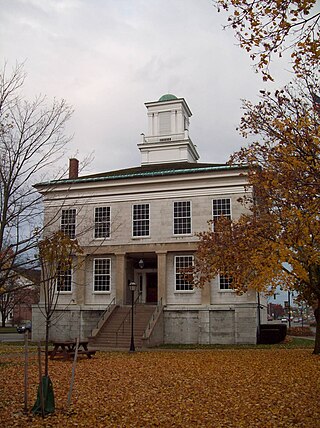
Genesee County is a county in the U.S. state of New York. As of the 2020 census, the population was 58,388. Its county seat is Batavia. Its name is from Seneca word Gen-nis'-hee-yo, meaning "the Beautiful Valley". The county was created in 1802 and organized in 1803.

Letchworth State Park is a 14,427-acre (5,838 ha) New York State Park located in Livingston County and Wyoming County in the western part of the State of New York. The park is roughly 17 miles (27 km) long, following the course of the Genesee River as it flows north through a deep gorge and over several large waterfalls. It is located 35 miles (56 km) southwest of Rochester and 60 miles (97 km) southeast of Buffalo, and spans portions of the Livingston County towns of Leicester, Mount Morris and Portage, as well as the Wyoming County towns of Castile and Genesee Falls.

Mayville is a village in Chautauqua County, New York, United States. The population was 1,477 at the 2020 census, 13.7% less than in the 2010 census. Mayville is in the town of Chautauqua and is the county seat of Chautauqua County. The village and town offices share a building on Main Street, directly across from the Chautauqua County courthouse.

The Holland Land Company was an unincorporated syndicate of thirteen Dutch investors from Amsterdam, headquartered in Philadelphia, who purchased large tracts of American land for development and speculation. Their primary purchase was that of the western two-thirds of the Phelps and Gorham Purchase in 1792 and 1793, an area that afterward was known as the Holland Purchase. Additional lands were purchased in northwest Pennsylvania. Aliens were forbidden from owning land within New York State, except by special acts of the New York State Legislature, so investors placed their funds in the hands of certain trustees who bought the land in central and western New York State. The syndicate hoped to sell the land rapidly at a great profit. Instead, for many years they were forced to make further investments in their purchase; surveying it, building roads, digging canals, to make it more attractive to settlers. They influenced state policy in New York to allow foreign ownership of the land, avoid new taxes, and promote the construction of the Erie Canal and government roads on the company lands. They supported Governor Dewitt Clinton's faction in the state government to achieve these goals. The company finished selling its New York lands in 1839 and its Pennsylvania lands in 1849, and the company was liquidated in 1858.

The Phelps and Gorham Purchase was the sale, in 1788, of a portion of a large tract of land in western New York State owned by the Seneca nation of the Iroquois Confederacy to a syndicate of land developers led by Oliver Phelps and Nathaniel Gorham. The larger tract of land is generally known as the "Genesee tract" and roughly encompasses all that portion of New York State west of Seneca Lake, consisting of about 6,000,000 acres (24,000 km2).

Joseph Ellicott was an American surveyor, city planner, land office agent, lawyer and politician of the Quaker faith.

New York State Route 5 (NY 5) is a state highway that extends for 370.80 miles (596.74 km) across the state of New York in the United States. It begins at the Pennsylvania state line in the Chautauqua County town of Ripley and passes through Buffalo, Syracuse, Utica, Schenectady, and several other smaller cities and communities on its way to downtown Albany in Albany County, where it terminates at U.S. Route 9 (US 9), here routed along the service roads for Interstate 787 (I-787). Prior to the construction of the New York State Thruway, it was one of two main east–west highways traversing upstate New York, the other being US 20. West of New York, the road continues as Pennsylvania Route 5 (PA 5) to Erie.

Paul Busti was the Agent General of the Holland Land Company from 1799 until his death in 1824. As administrator of the Holland Land Company, Busti was responsible for the economic, political, and social development of large areas of central and western New York and northwestern Pennsylvania.

New York State Route 33 (NY 33) is an east–west state highway in western New York in the United States. The route extends for just under 70 miles (113 km) from NY 5 in Buffalo in the west to NY 31 in Rochester in the east. It is, in fact, the only state highway that directly connects both cities, although it is rarely used today for that purpose. The westernmost 10 miles (16 km) of NY 33 in Buffalo and the neighboring town of Cheektowaga have been upgraded into the Kensington Expressway. This section of NY 33 is one of several expressways leading out of downtown and serves as a main route to the Buffalo Niagara International Airport.

Ellicott Creek is a stream in Western New York, United States. It is a tributary of Tonawanda Creek, which in turn flows into the Niagara River.

Benjamin Ellicott was a surveyor, a county judge and a member of the United States House of Representatives from the State of New York.

Batavia Cemetery is located on Harvester Avenue in Batavia, New York, United States. It opened in 1823 and contains over 8,000 graves, mostly from the 19th century. In 2002 it was listed on the National Register of Historic Places, the first of two cemeteries in Genesee County to be so designated.

The Batavia Club building, built originally as the Bank of Genesee, is on the corner of East Main and Bank streets in Batavia, New York, United States. It is a brick Federal style building from the 1830s, one of the few remaining examples in New York of a commercial building in that style from that period.

The Genesee County Courthouse is located at the intersection of Main and Ellicott streets in Batavia, New York, United States. It is a three-story Greek Revival limestone structure built in the 1840s.

The Genesee County Courthouse Historic District is located at the junction of Main, West Main and Ellicott streets in downtown Batavia, New York, United States. It is a small area with the county courthouse, a war memorial and other government buildings dating from the 1840s to the 1920s. Some were originally built for private purposes.

The Le Roy House and Union Free School are located on East Main Street in Le Roy, New York, United States. The house is a stucco-faced stone building in the Greek Revival architectural style. It was originally a land office, expanded in two stages during the 19th century by its builder, Jacob Le Roy, an early settler for whom the village is named. In the rear of the property is the village's first schoolhouse, a stone building from the end of the 19th century.

The Stafford Village Four Corners Historic District is located at the junction of New York state routes 5 and 237 in Stafford, New York, United States. It is a collection of six buildings of various types from the 19th century, one of which is the oldest house in Genesee County.
The Treaty of Big Tree was a formal treaty signed in 1797 between the Seneca Nation and the United States, in which the Seneca relinquished their rights to nearly all of their traditional homeland in New York State—nearly 3.5 million acres. In the 1788 Phelps and Gorham Purchase, the Haudenosaunee (Iroquois) had previously sold rights to their land between Seneca Lake and the Genesee River. The Treaty of Big Tree signed away their rights to all their territory west of the Genesee River except 12 small tracts of land for $100,000 and other considerations. The money was not paid directly to the tribe, but was to be invested in shares of the Bank of the United States, and to be paid out to the Senecas in annual earnings of up to six percent, or $6,000 a year, on the bank stock.

Franklin Wellington Caulkins was a prominent architect in Buffalo, New York.

Batavia is a city in and the county seat of Genesee County, New York, United States. It is near the center of the county, surrounded by the Town of Batavia, which is a separate municipality. Batavia's population as of the 2020 census was 15,600. The name Batavia is Latin for the Betuwe region of the Netherlands, and honors early Dutch land developers. In 2006, a national magazine, Site Selection, ranked Batavia third among the nation's micropolitans based on economic development. The New York State Thruway passes north of the city. Genesee County Airport (GVQ) is also north of the city.






















